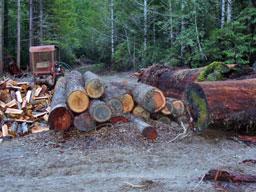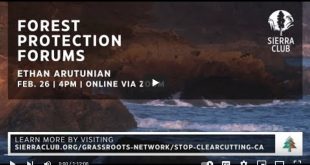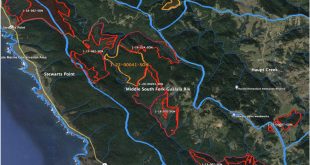Hernandez NTMP
1-06NTMP-009 SON
Why is Friends of the Gualala River (FoGR) concerned about abuses of non-industrial timber management plans (NTMPs)?
Why does Friends of the Gualala River oppose the Hernandez NTMP?
Use and abuse of NTMPs
Non-Industrial timber management plans (NTMPs) are, as the name suggests, intended for landowners who are not primarily engaged in manufacturing forest products such as timber, firewood or furniture for commercial sale. NTMPs are aimed at landowners who want to keep forestland forested and in non-intensive timber production, and avoid the need to sell timberland off for other uses. FoGR generally believes this purpose is valid.
We are concerned, however, that the ultra-light environmental review, minimal permit burden and “permanent permit” provided by NTMPs are attractive as a ‘back door’ to logging that is not benign. The permitted logging conditions are granted in perpetuity regardless of changing biological conditions, new development in the area, changing forest management needs, or future changes in the Forest Practices Act.
We are especially concerned because NTMPs carry almost no compliance or monitoring. CDF does even less of a “hard look” at NTMPs than it does THPs, and casually assumes that standard policies eliminate abuses or impacts. This is not realistic.
This plan is a relatively recent addition to the permit types available. Its popularity has skyrocketed and now constitutes a large proportion of those submitted to CDF.
We are seeing indications that NTMPs may be allowing forest product manufacturers to ride on the coattails of non-industrial co-applicants to gain access to NTMPs that would otherwise be denied them.
We are concerned that NTMPs are likely to be used as a way of removing forest biological resources in preparation for subsequent land conversion uses (like development) that are withheld from disclosure when applicants seek NTMPs. In other words, NTMPs may abused to make subsequent residential or agricultural conversions easier, while circumventing proper environmental review.
The Hernandez operations exploit irreplaceable downed old-grown redwood logs – essential and important forest habitat.
The Hernandez NTMP does not disclose the financial and commercial core of Hernandez’ operation: the harvest and milling of downed old growth redwood logs (“buckskins”), our last remaining old-growth forest habitat legacy.
Hernandez operates Old Growth Again and Old Growth Again Restoration Forestry, two related and nearly indistinguishable entities (one a non-profit organization, one a for-profit organization) that manufacture expensive old-growth redwood furniture and other forest products in the marketing guise of forest “restoration.”
The source of the redwood is irreplaceable old-growth buckskins that provide legacy forest habitat. Downed redwood logs (‘buckskins’) can take hundreds of years to decompose, during which time they retain water and nutrients, providing habitat for a multitude of species of plants, invertebrates and animals. New trees take root in the downed redwoods, which also fertilize the next generation of redwoods. Hernandez’ operations exploit the merchantable undecayed buckskins, which cannot be replaced in kind.
 The Hernandez NTMP does not disclose the buckskin harvest and milling in the NTMP. CDF claims that this exploitation is merely “personal use,” despite the commercial Old Growth Again website catalogue and order forms for milled old-growth redwood products (www.oldgrowthagain.com).
The Hernandez NTMP does not disclose the buckskin harvest and milling in the NTMP. CDF claims that this exploitation is merely “personal use,” despite the commercial Old Growth Again website catalogue and order forms for milled old-growth redwood products (www.oldgrowthagain.com).
Mysteriously, CDF claims to generally regulate the harvest and milling of downed old-growth logs in the NTMP, but fails to do so for Hernandez. CDF uncritically accepted Hernandez’ argument that the buckskins are either for “personal use” or obtained from offsite (without identifying the CDF permit to harvest buckskins). Given the nature of the redwood furniture commercial operation, we find this incredible.
FoGR members are careful observers and neighbors of Hernandez-managed and owned forest parcels, and we dispute the validity of the claim that Hernandez-managed parcels, depleted of downed old-growth redwood logs, are “restored” in any meaningful sense. Proper thinning may accelerate redwood growth, but the commercial harvest of buckskins is unethical, unsound, and profoundly misleading “restoration” of forest habitat. Additionally, the present logging of all of the largest existing second growth redwood trees from the NTMP parcels does not support OGA’s contention that it is dedicated to bringing back any semblance of an old growth forest anytime soon.
Hernandez NTMP sets an adverse precedent for NTMP eligibility, opening back doors to commercial timber operations.
 The Hernandez NTMP applicants include Raul Hernandez, who is primarily engaged in commercial harvest and manufacture of timber products – exactly what NTMPs are meant to exclude.
The Hernandez NTMP applicants include Raul Hernandez, who is primarily engaged in commercial harvest and manufacture of timber products – exactly what NTMPs are meant to exclude.
Similarly, NTMPs prohibit lumping separate parcels under one NTMP (they require “contiguous” parcels). This prevents multiple small ownerships from being consolidated in excessive timber harvests under NTMPs. Hernandez abuses this by including non-contiguous parcels, with multiple owners, in one NTMP.
The prohibition against ‘lumping’ also prevents subjecting non-contiguous parcels with different topographies, soil types, species mixes, and management needs to ‘a one size fits’ all management plan under one NTMP.
Additional Information
- Downed Old Growth Redwood Logs
- Friends of the Gualala River v. CDF
– Petition filed in Superior Court, September, 2007 - Letter to CDF, February, 2007
- Hernandez NTMP documents on the CDF website
- Non-Industrial Timber Management Plans in California
– Report to the Legislature by CDF, October, 2003
 Friends of Gualala River Protecting the Gualala River watershed and the species living within it
Friends of Gualala River Protecting the Gualala River watershed and the species living within it


